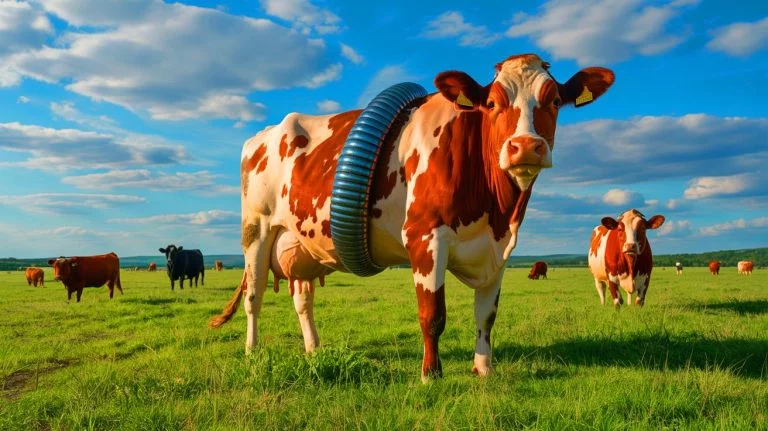| IN A NUTSHELL |
|
The resurgence of the New World screwworm in North and Central America has sparked significant concern among experts and the cattle industry alike. This flesh-eating parasitic fly, which was previously eradicated from these regions, is making an alarming comeback. The fly poses a severe threat not only to the cattle industry but also to a wide range of hosts, including humans and their pets. As the New World screwworm continues to spread northward, understanding the biology behind its infestation and the measures required to combat it becomes crucial.
The Return of the Screwworm: A Complex Threat
The return of the New World screwworm to North and Central America is a multifaceted issue. This parasitic fly, known scientifically as Cochliomyia hominivorax, was successfully eradicated from the United States and Mexico between the 1960s and 1990s through the strategic use of the sterile insect technique (SIT). This method involved releasing billions of sterile male flies, effectively halting reproduction and leading to the fly’s eradication. However, since 2022, there has been a resurgence of the screwworm in several Central American countries, with cases exploding in Panama in 2023 and reaching Mexico by November 2024.
Several hypotheses have been proposed to explain this resurgence, including the possibility of screwworms hitchhiking with cattle movements and higher temperatures enhancing fly development and survival. Another alarming concern is that female screwworms might be adapting their behavior to avoid mating with sterile males, undermining the effectiveness of SIT. The potential impact on the cattle industry is profound, with millions of cattle at risk, particularly in regions like Texas and Florida. Additionally, humans are not immune, with at least eight cases of human infestation reported in Mexico since April.
The Biology and Impact of Screwworm Infestation
Understanding the biology of the New World screwworm is crucial in addressing the current threat. The female screwworm is attracted to the odor of any wound, where she lays her eggs. Once hatched, the larvae, or maggots, feed aggressively on living tissue, causing immense suffering and, if untreated, death to their host. This behavior poses a significant threat to livestock, wildlife, and even humans. During the 1960s, cattle farmers in Texas treated around one million cases of screwworm infestation annually, highlighting the potential economic impact if the fly is not controlled.
Ecologically, flies play important roles such as pollination and the decomposition of organic matter. However, the New World screwworm has evolved to feed on living tissue, leading to devastating effects. The economic ramifications are considerable, as the previous eradication campaign reportedly cost $750 million, but it also allowed for significant increases in cattle production. The current spread of this fly necessitates urgent measures to prevent history from repeating itself.
Strategies for Eradication and Control
Efforts to counter the spread of the New World screwworm are underway, with the US and Central American governments working together to enhance surveillance and eradication measures. Sterile insect releases remain a cornerstone of these efforts, with a facility in Panama producing over 100 million sterile flies per week. This initiative is jointly funded by the US Department of Agriculture (USDA) and Panama’s Ministry of Agriculture Development. However, the scale of the current infestation may require several times this number of sterile flies.
To meet this demand, the USDA is investing $21 million to equip a fruit fly production facility in Metapa, Mexico, to produce an additional 60 million to 100 million sterile screwworms per week. Moreover, integrated control measures, including anti-parasitic veterinary medicines, are critical in repelling flies and treating infestations. Surveillance with trained personnel is essential, although challenging, as an entire generation of veterinarians and farmers lack experience with screwworm infestations.
The Role of Climate and Future Challenges
Climate change adds another layer of complexity to the eradication efforts. Historically, cool weather contributed to the successful eradication of the New World screwworm. However, with global warming, such favorable conditions may not be available, impacting current eradication plans. Researchers are working to understand how these changes will affect the fly’s behavior and the effectiveness of ongoing control strategies.
As the screwworm continues to pose a threat, it is crucial to adapt and enhance eradication efforts to prevent its spread further north. The situation underscores the need for continued research and collaboration among countries to protect both livestock and human populations. How can we leverage modern technology and international cooperation to develop more effective strategies against such persistent biological threats?
Did you like it? 4.5/5 (27)








Wow, this sounds like something out of a horror movie! 😱
Can this really happen? It sounds too crazy to be true. 🤔
Thank you for the thorough explanation. Scary stuff!
What measures can people take to protect themselves and their pets?
So, is climate change the main culprit here, or are there other factors?
How effective is the sterile insect technique now compared to the past?
Does this mean we should be worried about our pets when we take them outside?
Great article, but some of these links seem unrelated. 🤷♂️
I’m glad to see international cooperation on this issue. 🌎
This is terrifying! Are there any areas in the US that are most at risk?
Is this the same screwworm that affected livestock in the 1960s?
Wouldn’t more pesticides help control the fly population?
Hopefully, the USDA’s efforts will be enough to stop this!
Has there been any progress with gene editing to combat these flies?
Why are these flies so hard to control in the first place?
I wonder if there are natural predators that could help control the population.
How can the average person help in these eradication efforts?
Can affected animals recover from screwworm infestations?
Thanks for bringing attention to this issue. It’s crucial we stay informed.
Are there any signs that indicate a screwworm infestation in pets? 🐶🐱
Could this impact food prices if the cattle industry suffers?
What are the long-term environmental impacts of using sterile insect techniques?
This sounds like a sci-fi plot! What’s next, zombie flies? 😂
Is there any chance these flies could spread to other continents?
How do these flies manage to hitchhike with cattle movements?
Is there any good news in this situation? It seems all doom and gloom.
What role do governments play in preventing the spread of these flies?
How do sterile flies help, and why don’t they just die out?
Are there any vaccines or treatments in development for screwworm infestations?
This article was an eye-opener. Keep up the great reporting!
Has anyone considered the ecological role these flies play, despite the horror?
What’s the timeline for these eradication efforts? ⏳
Can screwworm infestations be mistaken for other diseases in livestock?
Do screwworms affect all animals, or are some more susceptible than others?
Why is the sterile insect technique considered the best approach? 🤔
Is there any community involvement in these eradication strategies?